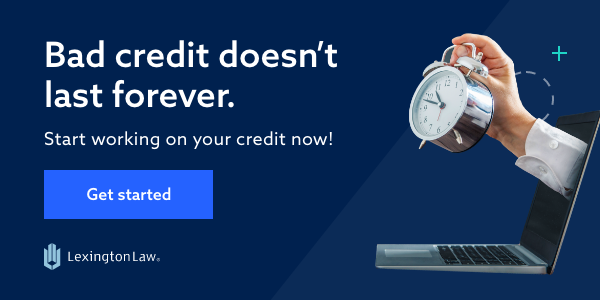
The information provided on this website does not, and is not intended to, act as legal, financial or credit advice. See Lexington Law’s editorial disclosure for more information.
Update: On August 24, 2022, President Biden announced student loan forgiveness of up to $10,000 for qualified borrowers and up to $20,000 for qualifying Pell Grant recipients. Federal student loan payments will also remain paused through December 31, 2022. Further details are to be announced in the coming weeks.
Lately, the federal government canceling student loan debt seems, for the first time, like it could actually happen. As of 2020, approximately 45 million Americans owe over $1.64 trillion in student loans. Looking at the graduating class of 2019, 69 percent of students with four-year degrees had to take out a student loan and were completing their education with an average student loan debt of $29,900.
Because of this and other troubling student debt statistics, the government canceling student loan debt (aka a debt jubilee) would help out many students, graduates and parents.
What would it mean to cancel student loan debt?
There are already several existing programs that allow for student loan debt to be canceled or forgiven. Some of these programs are:
- Public Service Loan Forgiveness
- Teacher Loan Forgiveness
- Perkins Loan Cancellation
- Death Discharge
- Bankruptcy Discharge
- Unpaid Refund Discharge
- Total and Permanent Disability Discharge
- Closed School Discharge
- False Certification of Student Eligibility Discharge
- Unauthorized Signature/Payment Discharge
Many of these programs are difficult to qualify for or are reserved for rare circumstances. So, while these programs exist to help people in unfortunate situations, they don’t typically apply to the general population.
That’s why a greater and more widespread student loan debt cancellation would be fairly exceptional. However, it would come with some tax implications.
Typically, when borrowers have a debt forgiven, they have to follow the Cancellation of Debt (COD) federal income tax rule. This rule states that anytime a debt is forgiven, that amount must be claimed as income tax for the year the debt cancellation happens. However, there are some exceptions to the COD tax rule when it comes to student loans. COD is federal income-tax-free when:
- The loan is forgiven because the borrower worked in a specific profession (public sector, teaching, etc.)
- The exception is due to the student’s death or disability
- The student enacts the Defense of Repayment against the school (possible partial COD federal income tax exceptions may apply)
Under Joe Biden’s student loan plan, the massive rollout of a student loan debt cancellation would be tax-free. Of course, there’s no guarantee the version that will be approved by Congress will, in fact, be tax-free. If borrowers are forced to pay Cancellation of Debt federal income tax when their student loan is forgiven, it can cause what many are calling a “tax nightmare.”
Let’s say a borrower has $80,000 in student loan debt and $50,000 is forgiven. Under the COD, that $50,000 is added to their income tax for the year. How much they will ultimately pay in taxes will depend on which income tax bracket they fall in, as this $50,000 will be added to the income they’re already making in that year.
Assuming they’ll owe 30 percent in taxes on this $50,000 forgiveness, they can expect to see an income tax bill of $15,000 for their student loan forgiveness. Of course, this is still lower than paying back the $50,000 in full, but it’s a large sum that an average borrower might have difficulty paying back.
Benefits of canceling student loan debt
Canceling student loan debt has widespread benefits for individual borrowers and the American economy as a whole. Most importantly, this forgiveness would benefit lower-income people and groups that have been systemically disadvantaged.
Currently, less than 20 percent of white student loan borrowers have a debt-to-income ratio of more than 0.5. This means fewer than 20 percent of white borrowers make an annual income equal to half or less of their total student loan debt.
For African American borrowers, this number rises to 30 percent. As a result, more African American students leave college at a greater disadvantage than their white counterparts. Such a disparity is detrimental to the American economy, which benefits most when there’s a fair and fully versatile workforce.
Additionally, canceling student loan debt will offset the unreasonable costs of education. The cost of university has been rising faster than the average household income. When students graduate with excessive student loan debt, they don’t have as much disposable income and struggle to buy homes, start businesses or pay back debts. This is a detriment to the economy overall.
The downside
One downside that many people bring up is that privileged families that don’t have issues paying back their student loan debt and choose to take expensive degrees will benefit from this initiative as well. However, the vast majority of borrowers are working-class and lower-income, and these are the people who would most benefit from the cancelation of student loan debt.
What is Joe Biden’s student loan plan?
Joe Biden has a comprehensive student loan plan that will be quite exciting for many borrowers if Congress allows it through. Biden first mentioned a proposal to cancel up to $10,000 in federal student loans per borrower in March 2020. This was proposed to be included in the 2020 CARES Act but was not approved. However, there remains the hope that this will still be included in future stimulus packages.
The proposed Biden Plan for Education Beyond High School looks to update the Income-Driven Repayment (IDR) plan currently offered for federal student loans. As of right now, borrowers who choose the income-driven plan must pay between 10 and 20 percent of their income toward their loans. Biden’s proposed plan looks to lower this to five percent of income for borrowers making over $25,000. For individuals who make less than $25,000, there would be no interest and no monthly required payments.
Additionally, under Biden’s new plan, all borrowers automatically go under the IDR plan unless they opt out. Under the current plan, borrowers have a wide range of plans to choose from, with the default being equal monthly payments over 10 years. Additionally, under the new IDR plan, students would have their loans automatically forgiven after 20 years of payments with no income tax applied to the forgiven portion of their loan.
The Biden Plan for Education Beyond High School also highlighted that there would be a cap for student loan debt forgiveness. This cap is set to $10,000 per year for five years, so the maximum an individual borrower could get is $50,000. These caps would apply to both undergraduate and graduate debt.
Lastly, Biden’s plan looks to make student loan discharge in bankruptcy much easier (to date, it’s been very difficult) and provide free tuition for students whose families make less than $125,000 per year.
Other ideas being considered
U.S. Senate Candidate for Georgia Dr. A. Wayne Johnson has a close history with student loans. Previously, Johnson ran the student loan program at the U.S. Department of Education. Now, Johnson is proposing counter-ideas to Biden’s plan. His suggestions include:
- Suspending student loan payments (and accruing interest) until the end of 2021.
- Canceling all student loan debt (private and federal) that’s currently in bankruptcy
- Canceling up to $50,000 per student in student loan debt—students who don’t have a student loan would be awarded an income tax credit of $50,000 instead
- Removing student loan details from credit reports
Similarly, U.S. Senator Elizabeth Warren wants to cancel $50,000 of student loan debt for every borrower whose family makes less than $125,000 annually.
How likely is it that student loan debt will be canceled?
With the election of Joe Biden, there’s a strong possibility that some version of canceling student loan debt will pass. The ultimate question will be what form it takes.
Will students see partial forgiveness or a wipeout of all their loans, or will the forgiveness only apply to low-income borrowers? It will depend on what Biden wants and what Congress allows to pass. Since Congress controls federal spending, Biden will likely need Congress’s approval for any plan to happen, which has the potential to be problematic.
Managing your student loans
Don’t wait for student loan forgiveness to happen to you, because it’s unclear what the future holds. For now, keep managing your student loans responsibly—make payments on time and in full, because otherwise, you can hurt your credit score.
As you make progress on your student loans, keep an eye on the news. You can watch as a clearer picture forms and it becomes public knowledge what the American government will do about student loan debt. Hopefully, there will be some good news soon.
Note: Articles have only been reviewed by the indicated attorney, not written by them. The information provided on this website does not, and is not intended to, act as legal, financial or credit advice; instead, it is for general informational purposes only. Use of, and access to, this website or any of the links or resources contained within the site do not create an attorney-client or fiduciary relationship between the reader, user, or browser and website owner, authors, reviewers, contributors, contributing firms, or their respective agents or employers.
